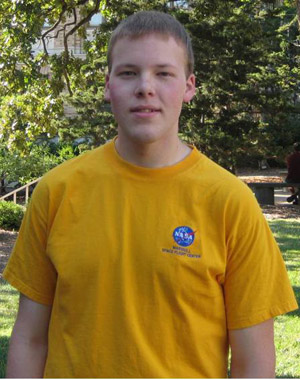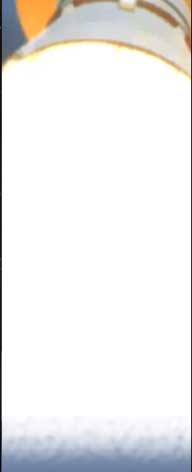|
 In early 2007, I applied through the Missouri-Space Grant Consortium to work as a summer intern at NASA’s Goddard Space Flight Center (GSFC) in Greenbelt, Maryland. I had the great fortune to be chosen for a position in the Exploration Systems Mission Directorate (ESMD), where I supported flight performance for the Constellation Program. Under the direction of Dr. Jesse Leitner and engineers in the Flight Dynamics Analysis Branch, I used Goddard’s General Mission Analysis Tool (GMAT) to simulate orbits about the Earth-Moon L1 libration point, one of five regions in the vicinity of the Earth and Moon where the gravitational pull of the two bodies equals the centripetal force required to rotate with them. A third, smaller mass orbiting one of these points can theoretically remain stationary with respect to the Earth and Moon. Located on a line between the two bodies, the Earth-Moon L1 point could be useful as a staging location for spacecraft in transit to the Moon or Mars.
Before beginning this analysis, I familiarized myself with the software by simulating a rendezvous between the Crew Exploration Vehicle (CEV) of the Constellation Program and the International Space Station (ISS). The complexities involved in rendezvous operations became apparent after my first week using GMAT. Orbital parameters had to be considered, as well as the time to wait before performing maneuvers to ensure the spacecraft were positioned correctly relative to one another. GMAT uses a differential corrector and an optimizer, which are sensitive to initial conditions. On most occasions, it was necessary to provide the optimizer with an initial guess close to the actual value, and to solve for some parameters using equations from orbital mechanics.
The goal in my research of the Earth-Moon L1 point was to explore the relationship between ?V and transfer time for trajectories between L1 orbits and the Moon. I found the problem most interesting for its usefulness in future missions, and for the knowledge I gained through the project. I felt like I learned a great deal from the engineers in my branch who were also interested in the research and helpful in creating the simulations.
In addition to my work with GMAT, I had many opportunities to view other aspects of spacecraft design and testing at the Goddard facilities. By the end of week 1, I had experience using 3-D orbital software to maneuver the shuttle arm in a simulated Hubble Space Telescope repair mission, and I was able to tour the spacecraft testing and mission operations facilities later in the summer. A highlight of my experience at Goddard was gaining access to two clean tents, where I viewed the propulsion modules of both the Lunar Reconnaissance Orbiter and the Solar Dynamics Observatory up close, learning from engineers assembling and testing each. The opportunity to intern at Goddard fulfilled a dream, and I am certain this is the career I would like to pursue.
In early 2007, I applied through the Missouri-Space Grant Consortium to work as a summer intern at NASA’s Goddard Space Flight Center (GSFC) in Greenbelt, Maryland. I had the great fortune to be chosen for a position in the Exploration Systems Mission Directorate (ESMD), where I supported flight performance for the Constellation Program. Under the direction of Dr. Jesse Leitner and engineers in the Flight Dynamics Analysis Branch, I used Goddard’s General Mission Analysis Tool (GMAT) to simulate orbits about the Earth-Moon L1 libration point, one of five regions in the vicinity of the Earth and Moon where the gravitational pull of the two bodies equals the centripetal force required to rotate with them. A third, smaller mass orbiting one of these points can theoretically remain stationary with respect to the Earth and Moon. Located on a line between the two bodies, the Earth-Moon L1 point could be useful as a staging location for spacecraft in transit to the Moon or Mars.
Before beginning this analysis, I familiarized myself with the software by simulating a rendezvous between the Crew Exploration Vehicle (CEV) of the Constellation Program and the International Space Station (ISS). The complexities involved in rendezvous operations became apparent after my first week using GMAT. Orbital parameters had to be considered, as well as the time to wait before performing maneuvers to ensure the spacecraft were positioned correctly relative to one another. GMAT uses a differential corrector and an optimizer, which are sensitive to initial conditions. On most occasions, it was necessary to provide the optimizer with an initial guess close to the actual value, and to solve for some parameters using equations from orbital mechanics.
The goal in my research of the Earth-Moon L1 point was to explore the relationship between ?V and transfer time for trajectories between L1 orbits and the Moon. I found the problem most interesting for its usefulness in future missions, and for the knowledge I gained through the project. I felt like I learned a great deal from the engineers in my branch who were also interested in the research and helpful in creating the simulations.
In addition to my work with GMAT, I had many opportunities to view other aspects of spacecraft design and testing at the Goddard facilities. By the end of week 1, I had experience using 3-D orbital software to maneuver the shuttle arm in a simulated Hubble Space Telescope repair mission, and I was able to tour the spacecraft testing and mission operations facilities later in the summer. A highlight of my experience at Goddard was gaining access to two clean tents, where I viewed the propulsion modules of both the Lunar Reconnaissance Orbiter and the Solar Dynamics Observatory up close, learning from engineers assembling and testing each. The opportunity to intern at Goddard fulfilled a dream, and I am certain this is the career I would like to pursue.
~TONYA SANDERS, UNIVERSITY OF MISSOURI-ROLLA
|







